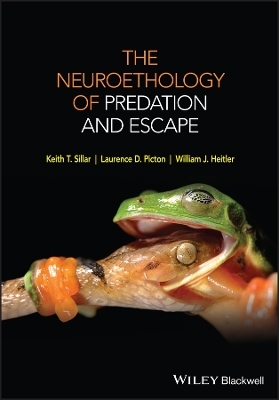
The Neuroethology of Predation and Escape
Wiley-Blackwell (Verlag)
978-0-470-97223-6 (ISBN)
THE NEUROETHOLOGY OF PREDATION AND ESCAPE
To eat and not get eaten is key to animal survival, and the arms race between predators and prey has driven the evolution of many rapid and spectacular behaviours.
This book explores the neural mechanisms controlling predation and escape, where specialisations in afferent pathways, central circuits, motor control and biomechanics can be traced through to natural animal behaviour.
Each chapter provides an integrated and comparative review of case studies in neuroethology. Ranging from the classic studies on bat biosonar and insect counter-measures, through to fish-eating snails armed with powerful neurotoxins, the book covers a diverse and fascinating range of adaptations. Common principles of biological design and organization are highlighted throughout the text.
The book is aimed at several audiences:
for lecturers and students. This synthesis will help to underpin the curriculum in neuroscience and behavioural biology, especially for courses focusing on neuroethology
for postgraduate students. The sections devoted to your area of specialism will give a flying start to your research reading, while the other chapters offer breadth and insights from comparative studies
for academic researchers. The book will provide a valuable resource and an enjoyable read
Above all, we hope this book will inspire the next generation of neuroethologists.
Keith T. Sillar School of Psychology and Neuroscience, University of St Andrews, Scotland, UK Laurence D. Picton School of Psychology and Neuroscience, University of St Andrews, Scotland, UK William J. Heitler School of Biology, University of St Andrews, Scotland, UK
General Introduction xi
What This Book Is About xiii
How this book is organised xv
Who this book is for xvi
Acknowledgements xvi
References xvii
1 Vision 2
1.1 The electromagnetic spectrum 3
1.2 Eyes: acuity and sensitivity 5
1.2.1 Foveae 6
1.3 Feature recognition and releasing behaviour 8
1.4 Prey capture in toads 9
1.4.1 Attack or avoid: ‘worms’ and ‘anti‐worms’ 9
1.4.2 Retinal processing 11
1.4.3 Feature detector neurons 12
1.4.4 Modulation and plasticity 14
1.4.5 Toad prey capture: the insects fight back 15
1.5 Beyond the visible spectrum 16
1.5.1 Pit organs 16
1.5.2 Thermotransduction 20
1.5.3 Brain processing and cross‐modal integration 21
1.5.4 Behaviour 22
1.5.5 Infrared defence signals 25
1.6 Aerial predators: dragonfly vision 27
1.6.1 Dragonfly eyes 27
1.6.2 Aerial pursuit 28
1.6.3 Predictive foveation 29
1.6.4 Reactive steering: STMDs and TSDNs 30
1.7 Summary 31
Abbreviations 32
References 32
2 Olfaction 36
2.1 Mechanisms of olfaction 38
2.1.1 Detection and specificity 38
2.1.2 Olfactory sub‐systems 40
2.1.3 Brain processing 41
2.2 Olfactory tracking and localisation 41
2.3 Pheromones and kairomones 45
2.3.1 Alarm pheromones 45
2.3.2 Predator odours 46
2.3.3 Dual purpose signals: the MUP family 47
2.3.4 Parasites: when kairomones go bad! 49
2.4 Summary 50
Abbreviations 51
References 51
3 Owl Hearing 54
3.1 Timing and intensity 56
3.2 Owl sound localisation mechanisms 58
3.3 Anatomy 60
3.4 Neural computation 61
3.4.1 The auditory map 62
3.4.2 Early stage processing 66
3.4.3 ITD processing 69
3.4.4 IID processing 76
3.5 Combining ITD and IID specificity in the inferior colliculus 77
3.6 Audio‐visual integration and experience‐dependent tuning of the auditory map 78
3.6.1 Audio‐visual discrepancy can re‐map the ICC‐ICX connections 80
3.6.2 Motor adaptation 82
3.6.3 Age and experience matter! 82
3.6.4 Cellular mechanisms of re‐mapping 82
3.7 Summary 83
Abbreviations 84
References 85
4 Mammalian Hearing 88
4.1 Spectral cues 90
4.1.1 Neural processing of spectral cues 90
4.2 Binaural processing 92
4.2.1 IID processing 93
4.2.2 ITD processing 94
4.2.3 Calyx of Held 99
4.3 Do mammals have a space map like owls? 100
4.4 Comparative studies in mammals 101
4.5 Summary 102
4.5.1 Caveats 102
Abbreviations 102
References 103
5 The Biosonar System of Bats 106
5.1 Bat echolocation 107
5.1.1 Why ultrasound? 108
5.1.2 Range limits 109
5.2 The sound production system 109
5.2.1 Types of sound: CF and FM pulses 110
5.2.2 Echolocation in predation: a three‐phase attack strategy 112
5.2.3 Duty cycle and pulse‐echo overlap 113
5.3 The sound reception system 114
5.3.1 Bats have big ears 114
5.3.2 Peripheral specialisations: automatic gain control and acoustic fovea 115
5.4 Eco‐physiology: different calls for different situations 116
5.4.1 Target discovery 117
5.4.2 Target range and texture 118
5.4.3 Target location 119
5.4.4 Target velocity: the Doppler shift 119
5.4.5 Target identity: flutter detection 121
5.4.6 Jamming avoidance response 123
5.4.7 Food competition and intentional jamming 123
5.5 Brain mechanisms of echo detection 124
5.5.1 The auditory cortex 125
5.5.2 Range and size analysis: the FM‐FM area 125
5.5.3 Velocity analysis: the CF‐CF area 128
5.5.4 Fine frequency analysis: the DSCF area 130
5.6 Evolutionary considerations 131
5.7 The insects fight back 132
5.7.1 Moth ears and evasive action 132
5.7.2 Bad taste 133
5.7.3 Shouting back 134
5.8 Final thoughts 135
5.9 Summary 136
Abbreviations 137
References 137
6 Electrolocation and Electric Organs 140
6.1 Passive electrolocation 142
6.1.1 Ampullary electroreceptors 142
6.1.2 Prey localisation 145
6.1.3 Mammalian electrolocation 146
6.2 Electric fish 148
6.3 Strongly electric fish 151
6.3.1 Freshwater fish: the electric eel 151
6.3.2 Marine fish: The electric ray 156
6.3.3 Avoiding self‐electrocution 158
6.4 Active electrolocation 158
6.4.1 Weakly electric fish 158
6.4.2 Tuberous electroreceptors 161
6.4.3 Brain maps for active electrolocation 163
6.4.4 Avoiding detection mostly 164
6.4.5 Frequency niches 166
6.4.6 The jamming avoidance response 167
6.5 Summary 174
Abbreviations 175
References 175
7 The Crayfish Escape Tail‐Flip 178
7.1 Invertebrate vs. vertebrate nervous systems 179
7.2 Tail‐flip form and function 180
7.3 Command neurons 182
7.4 Motor output 184
7.4.1 Directional control 184
7.4.2 Rectifying electrical synapses 186
7.4.3 Depolarising inhibition 188
7.4.4 FF drive and the segmental giant neuron 189
7.4.5 Limb activity during GF tail‐flips 189
7.4.6 Tail extension 190
7.4.7 Non‐giant tail‐flips 190
7.5 Activation of GF tail‐flips 191
7.5.1 Coincidence detection 193
7.5.2 Habituation and prevention of self‐stimulation 195
7.6 Modulation and neuroeconomics 196
7.6.1 Mechanisms of modulation 197
7.6.2 Serotonin modulation 198
7.7 Social status, serotonin and the crayfish tail‐flip 198
7.7.1 Social status effects on tail‐flip threshold 199
7.7.2 Serotonin effects on tail‐flip threshold depend on social status 200
7.8 Evolution and adaptations of the tail‐flip circuitry 202
7.8.1 Penaeus: a unique myelination mechanism gives ultra‐rapid conduction 205
7.9 Summary 208
Abbreviations 208
References 209
8 Fish Escape: the Mauthner System 212
8.1 Fish ears and the lateral line 214
8.1.1 Directional sensitivity 215
8.2 Mauthner cells 215
8.2.1 Biophysical properties 217
8.3 Sensory inputs to M‐cells 218
8.3.1 Feedforward inhibition and threshold setting 220
8.3.2 PHP neurons: electrical inhibition 220
8.4 Directional selectivity and the lateral line 222
8.4.1 Obstacle avoidance 223
8.5 M‐cell output 223
8.5.1 Feedback electrical inhibition: collateral PHP neurons 223
8.5.2 Spinal motor output 224
8.5.3 Spinal inhibitory interneurons: CoLos 224
8.6 The Mauthner system: command, control and flexibility 226
8.7 Stage 2 and beyond 230
8.8 Social status and escape threshold 230
8.9 Adaptations and modifications of the M‐circuit 233
8.10 Predators fight back: the amazing tentacled snake 235
8.11 Summary 239
Abbreviations 239
References 240
9 The Mammalian Startle Response 244
9.1 Pathologies 246
9.2 Neural circuitry of the mammalian startle response 248
9.3 Modulation of startle 250
9.4 Summary 250
Abbreviations 251
References 251
10 The Ballistic Attack of Archer Fish 254
10.1 The water pistol 255
10.2 Perceptual problems and solutions 257
10.3 Learning to shoot 260
10.4 Prey retrieval by archer fish 261
10.4.1 Computing the landing point 262
10.4.2 Orientation 263
10.4.3 Dash to the target 264
10.5 Summary 264
References 265
11 Catapults for Attack and Escape 266
11.1 The bow and arrow 268
11.2 Catapults require multi‐stage motor programmes 269
11.3 Grasshopper jumping 270
11.3.1 Biomechanics 270
11.3.2 The behaviour 270
11.3.3 The hind legs 271
11.3.4 The motor programme 273
11.3.5 Directional control 279
11.3.6 Evolution of the grasshopper strategy 279
11.4 Froghoppers: the champion insect jumpers 280
11.4.1 Ratchet locks 282
11.4.2 Synchronisation 282
11.5 Mantis shrimps 284
11.5.1 Mantis shrimp catapults 285
11.5.2 Cavitation bubbles 287
11.6 Snapping (pistol) shrimps 288
11.7 Multi‐function mouthparts: the trap‐jaw ant 291
11.8 Prey capture with prehensile tongues 293
11.8.1 The chameleon tongue: sliding springs and supercontracting muscles 293
11.8.2 Salamander tongue projection 297
11.9 Temperature independence of catapults 300
11.10 Summary 300
Abbreviations 301
References 301
12 Molluscan Defence and Escape Systems 304
12.1 Squid jet propulsion 306
12.1.1 Biomechanics 306
12.1.2 Neural circuitry 307
12.1.3 Jetting behaviour 311
12.2 Inking 312
12.2.1 Neuroecology of inking 314
12.2.2 Neural circuitry of inking 315
12.3 Cephalopod colour and shape control 316
12.3.1 Chromatophores 317
12.3.2 Iridophores 319
12.3.3 Leucophores 321
12.3.4 Photophores 321
12.3.5 Body shape and dermal papillae 322
12.4 Summary 323
Abbreviations 323
References 323
13 Neurotoxins for Attack and Defence 326
13.1 Cone snails 328
13.1.1 The biology of cone snail envenomation 329
13.1.2 Conopeptides 333
13.1.3 The billion dollar mollusc 340
13.1.4 ‘Rapid’ conch escape 341
13.2 The neuroethology of ‘zombie’ cockroaches 343
13.2.1 Sensory mechanisms of stinger precision 344
13.2.2 Transient paralysis 345
13.2.3 Intense grooming 346
13.2.4 Docile hypokinesia 346
13.3 Venom resistance 347
13.3.1 Targeting pain pathways 350
13.3.2 From pain to analgesia 350
13.4 Summary 352
Abbreviations 352
References 352
14 Concluding Thoughts 356
14.1 The need for speed 358
14.2 Safety in numbers 360
14.3 The unbalancing influences of humankind 361
References 363
Index 364
| Erscheint lt. Verlag | 6.5.2016 |
|---|---|
| Verlagsort | Hoboken |
| Sprache | englisch |
| Maße | 173 x 244 mm |
| Gewicht | 762 g |
| Themenwelt | Naturwissenschaften ► Biologie ► Ökologie / Naturschutz |
| Naturwissenschaften ► Biologie ► Zoologie | |
| ISBN-10 | 0-470-97223-8 / 0470972238 |
| ISBN-13 | 978-0-470-97223-6 / 9780470972236 |
| Zustand | Neuware |
| Haben Sie eine Frage zum Produkt? |
aus dem Bereich


